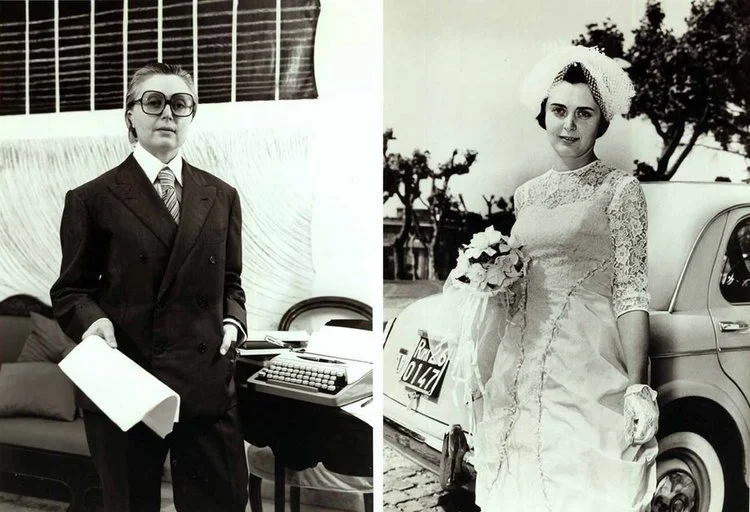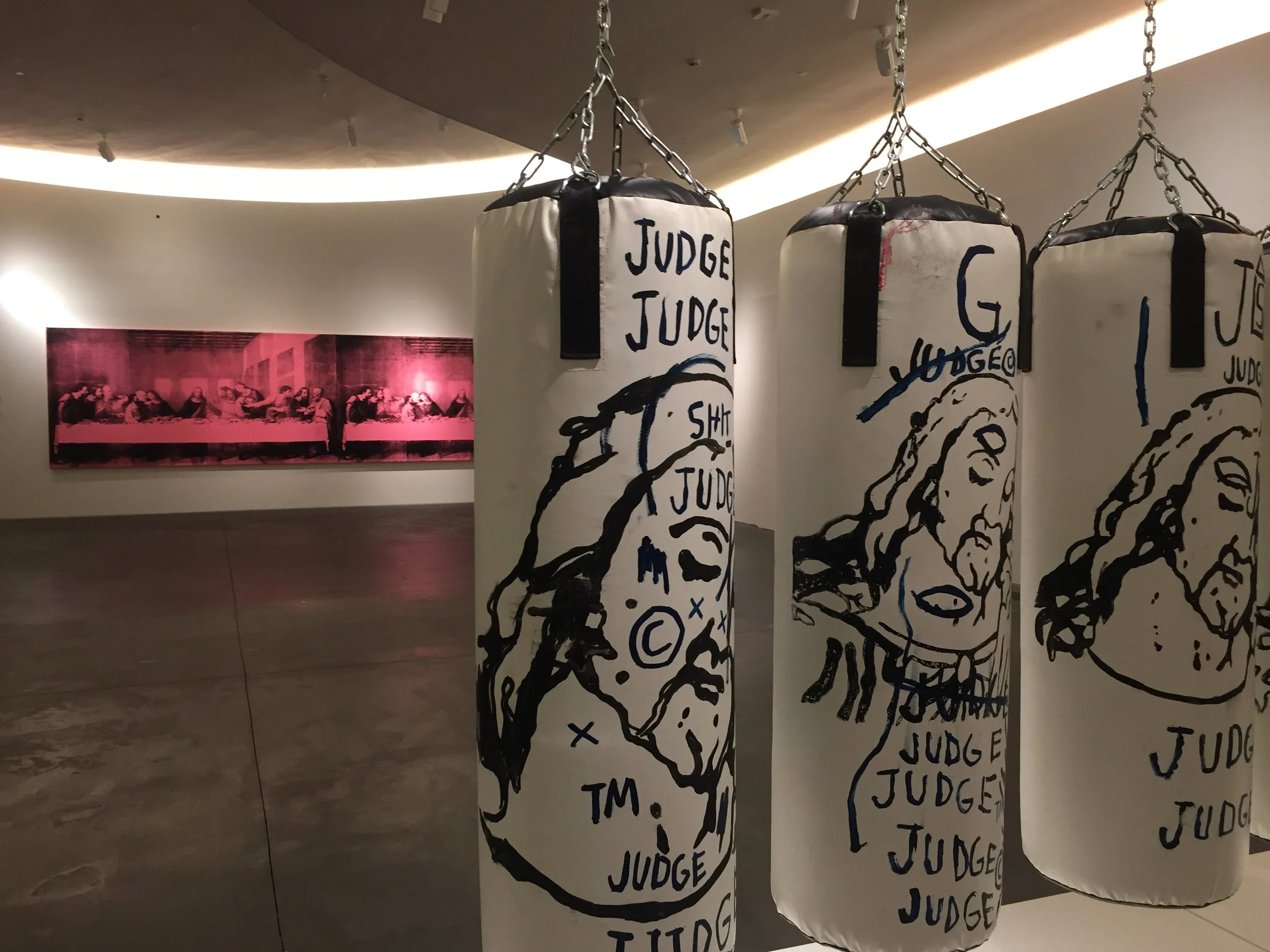Curation
Tomaso Binga - Poesia Muta
Brigade, Copenhagen, 2021
The artistic identity of Tomaso Binga came into being during Bianca Pucciarelli Menna’s ‘Oggi Spose’ performance in Rome, 1977, where she married her alter ego as a reaction to the lack of attention feminist art received in the 1970s. Binga has since worked under her male pseudonym to question male privilege in the art world and emphasize the gender issues inherent in art.
With an artistic practice that is based on linguistic experiments, Binga makes use of repetition and sarcasm as focal points to challenge masculine privileges. This is also expressed in the serial productions, such as Alfabeto Poetico Monumentale, that incorporates Binga’s body posed as letters.
The pseudonym Tomaso Binga came about, as Binga was her nickname as a child and Tomaso as an ambiguous reference to Filippo Tommaso Marinetti, the founder of the Futurist movement. In her own words, the male pseudonym ”[...] plays on irony and displacement; it seeks to expose the masculine privilege that is also dominant in art. It is a paradoxical challenge to an overarching social structure that we have partly inherited and partly want to break down as women.”
Born in Salerno in 1931, Binga’s artistic practice has endured for almost 50 years, but has only received the attention it deserves in the last decade where she, among other things opened several special exhibitions at leading exhibition venues and biennales in Europe, collaborated with Dior and is the process of having a documentary made about herself.
For more information
Fabio Mauri - The End
Heart - Herning Museum of Contemporary Art, 2019
Fabio Mauri was a central figure on the Italian art scene of the 1960s, alongside fellow artists and friends such as Piero Manzoni, Lucio Fontana and Jannis Kounellis . However, Mauri differentiated himself by focusing on issues such as rebellion, propaganda and nationalism. Mauri’s works raises many questions – including the subject of how he saw fascism seducing individuals, peoples and states.
From 1954 onwards, Fabio Mauri was part of the Italian avant-garde movement that rebelled against the traditions of art, particularly those of traditional painting. Mauri worked concurrently with other Italian artists such as Piero Manzoni, who tried to purge painting of all narrative content and meaning by getting rid of colour and recognisable motifs on the canvas. Like Manzoni, Mauri worked with monochrome surfaces, for example in the series Schermo (Screen) from 1958 to 1968. Mauri, however, did not set out to strip the surface of all meaning; rather, he wanted to explore how a work of art can produce memories, questioning what we each associate with the materials and forms seen in the work – as well as how art documents our story.
Mauri was interested in the meaning and significance conveyed by art, exploring, among other things, the meaning of the final screens seen in cinematic films, featuring the words ‘The End’. What might be the significance of such endings? All things in life must come to an end, and so the words ‘The End’ become a kind of memento mori. The term ‘Memento mori’ means ‘Remember that you must die’ and is used to describe works of art intended to remind us that life does not last forever. We are all going to die. Often, a skull is used as a symbol of human mortality, but in Mauri’s work the skull has been replaced by ‘The End’, which we may read as the ultimate conclusion to all – death.
Andy Warhol - The Man Behind the Myth
Heart - Herning Museum of Contemporary Art, 2016-17
Diving into the abyss that is Warholian scholarship and study, it quickly becomes apparent that it’s a murky water full of conflicting voices, anecdotes and, at times, even self-serving arguments from dubious sources. Because of this, I decided to take a somewhat constrained curatorial approach to both the exhibition, and the catalogue that accompanies it.
First of all I wanted to highlight some of the few pieces of knowledge, that can justifiably be deemed valid and above approach. These include Warhol’s sexuality, his faith, his fear of death and use of it in his art, all of which will be touched upon in this publication.
Secondly, I originally wanted to omit any quotations or anecdotes regarding Warhol that could be deemed doubtful, as there are so many conflicting voices that each claim truthfulness. However, all these voices surrounding him also forms the plethora of personal interpretations of both the person and the artist and therefore they do serve a purpose, though one should be careful to keep a bit of perspective about everything that is read.
It’s these kinds of misunderstandings that I seek to lie to rest in both exhibition and catalogue. My aim has been to peel away just a few layers of the veneer that has been applied to Warhol both during and after his lifetime. In order to do so, I have had to rely on the factual and the immediately obvious. In turn this has also afforded me the possibility to highlight elements of Warhol’s practice and personality that have perhaps not been generally appreciated by a wider public.
For more information
Alex Da Corte - 50 Wigs
Heart - Herning Museum of Contemporary Art, 2016-17
Diving into the abyss that is Warholian scholarship and study, it quickly becomes apparent that it’s a murky water full of conflicting voices, anecdotes and, at times, even self-serving arguments from dubious sources. Because of this, I decided to take a somewhat constrained curatorial approach to both the exhibition, and the catalogue that accompanies it.
First of all I wanted to highlight some of the few pieces of knowledge, that can justifiably be deemed valid and above approach. These include Warhol’s sexuality, his faith, his fear of death and use of it in his art, all of which will be touched upon in this publication.
Secondly, I originally wanted to omit any quotations or anecdotes regarding Warhol that could be deemed doubtful, as there are so many conflicting voices that each claim truthfulness. However, all these voices surrounding him also forms the plethora of personal interpretations of both the person and the artist and therefore they do serve a purpose, though one should be careful to keep a bit of perspective about everything that is read.
It’s these kinds of misunderstandings that I seek to lie to rest in both exhibition and catalogue. My aim has been to peel away just a few layers of the veneer that has been applied to Warhol both during and after his lifetime. In order to do so, I have had to rely on the factual and the immediately obvious. In turn this has also afforded me the possibility to highlight elements of Warhol’s practice and personality that have perhaps not been generally appreciated by a wider public.
Jesper Just - This is a landscape of desire
Heart - Herning Museum of Contemporary Art, 2013
MMCA -National Museum of Modern and Contemporary Art, Seoul, 2014
For more information




